Development of a high performance optical cesium beam

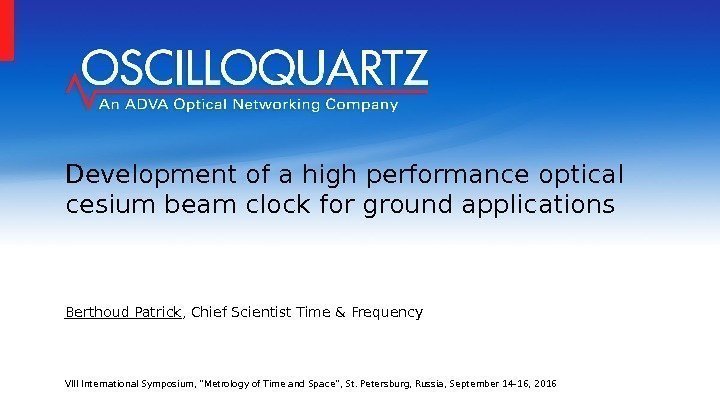
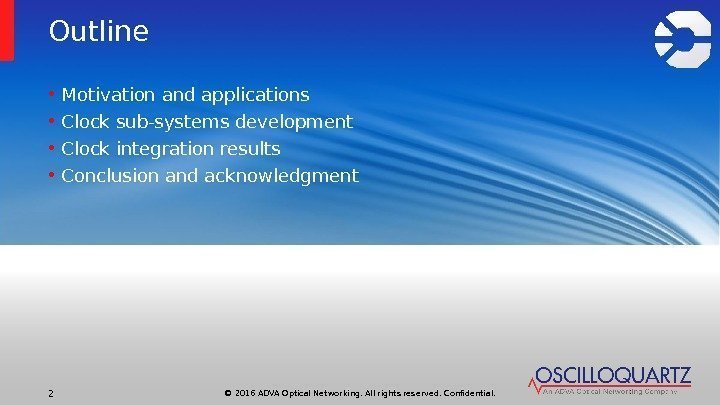
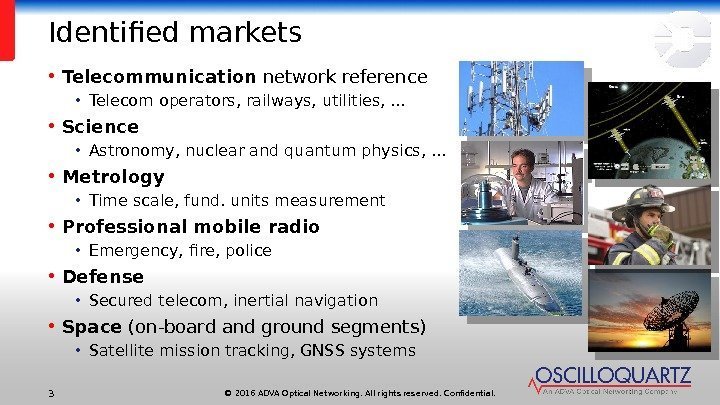
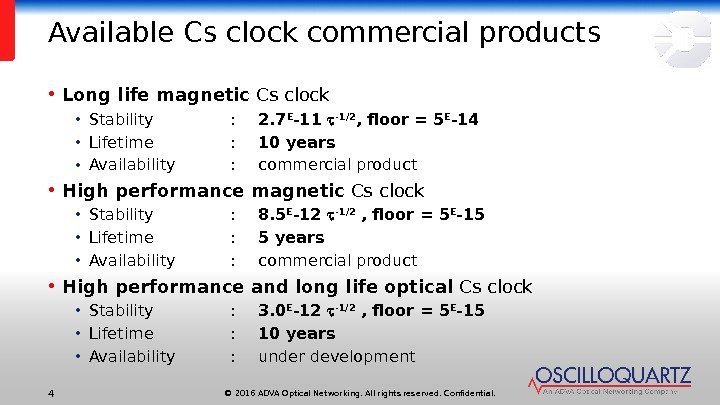
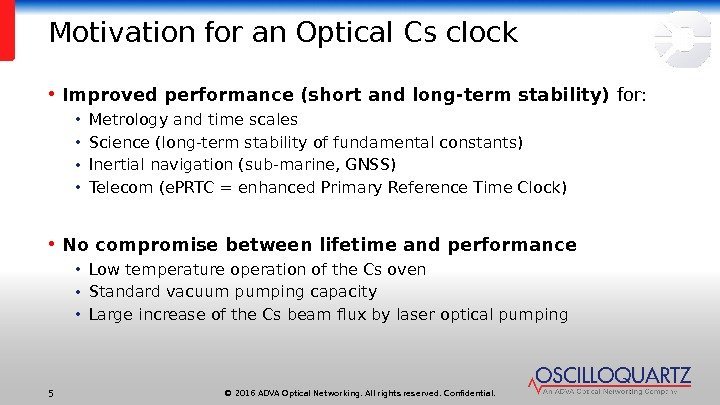
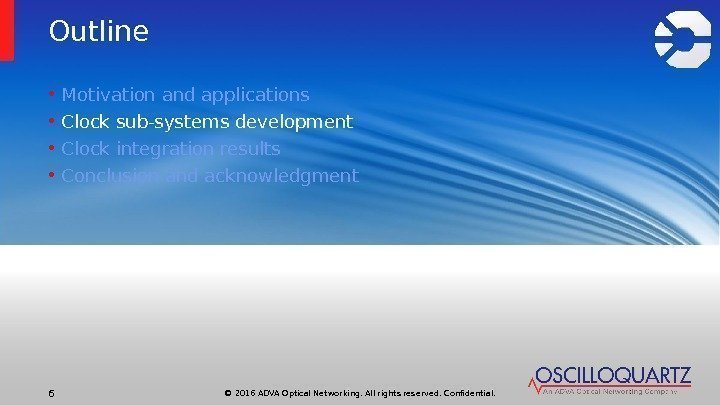
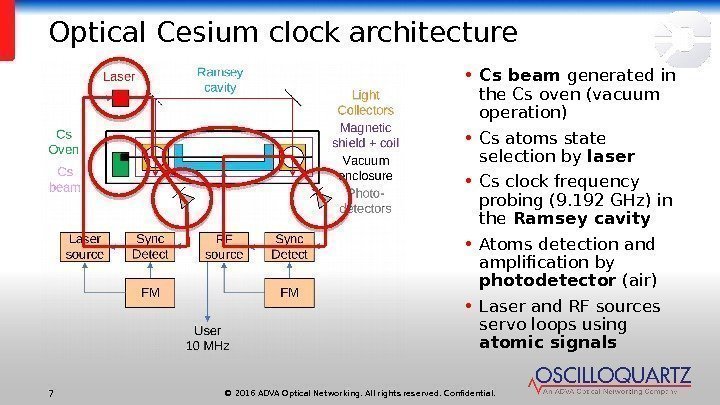
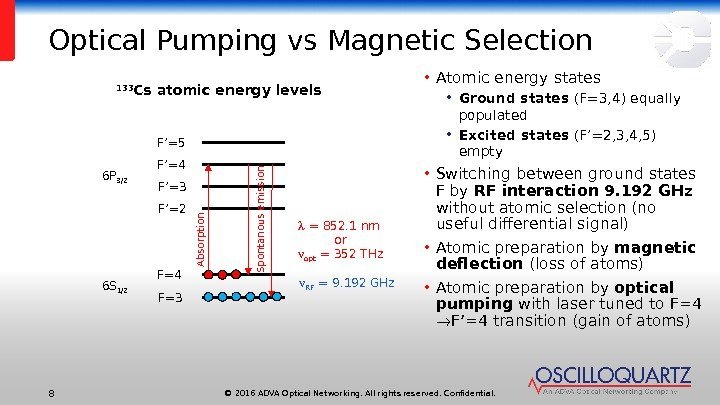

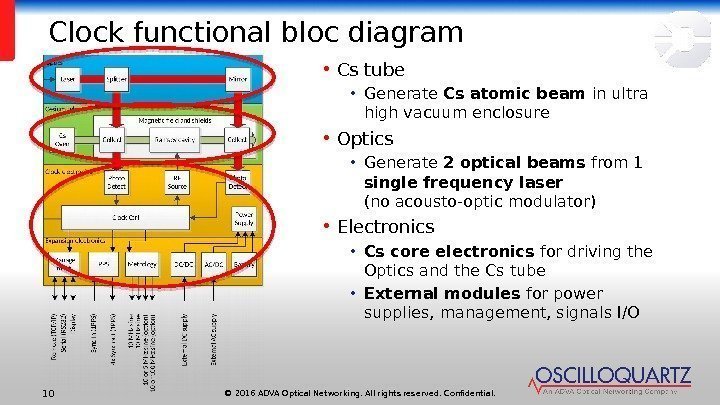
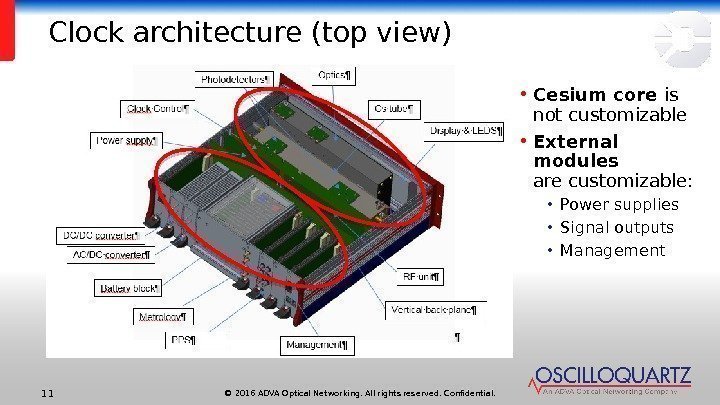
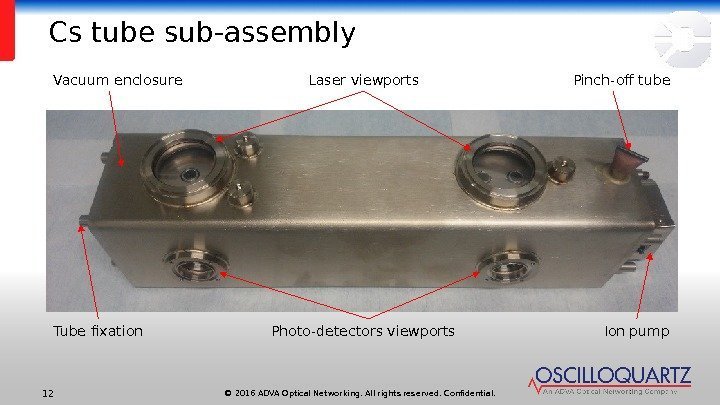
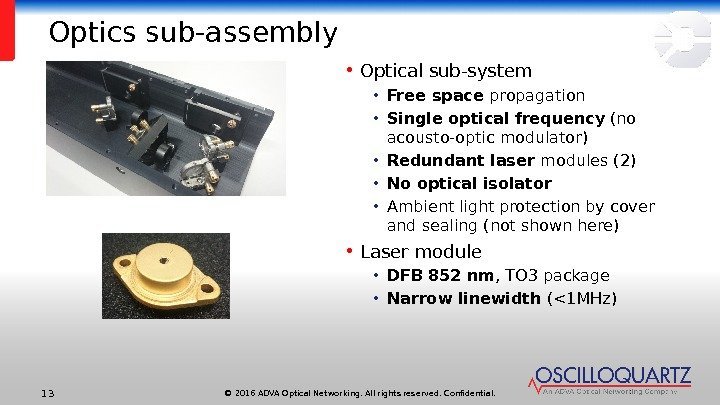
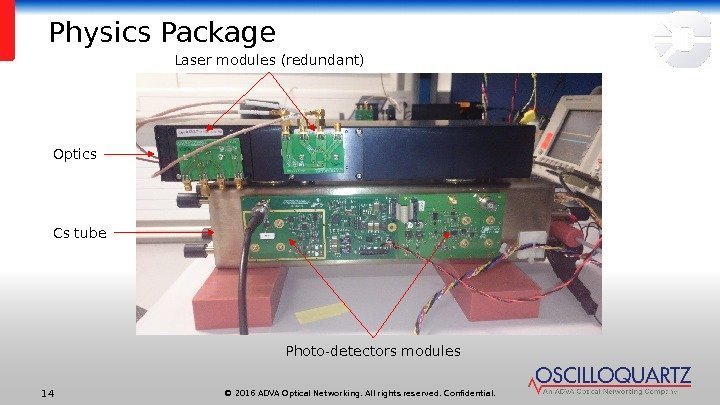
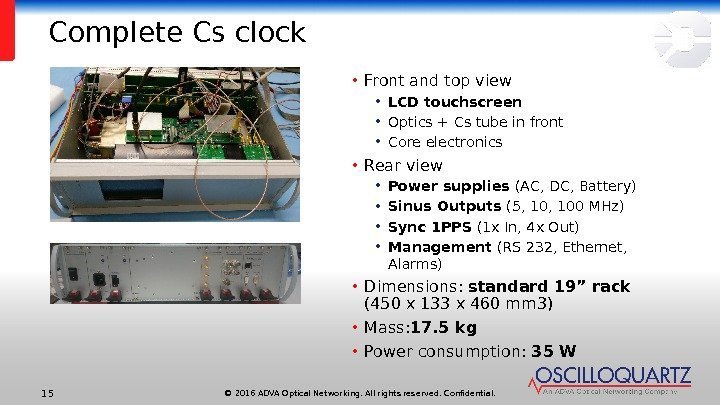
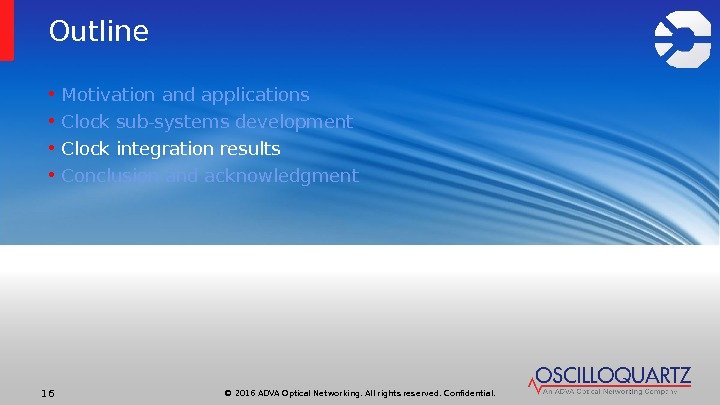
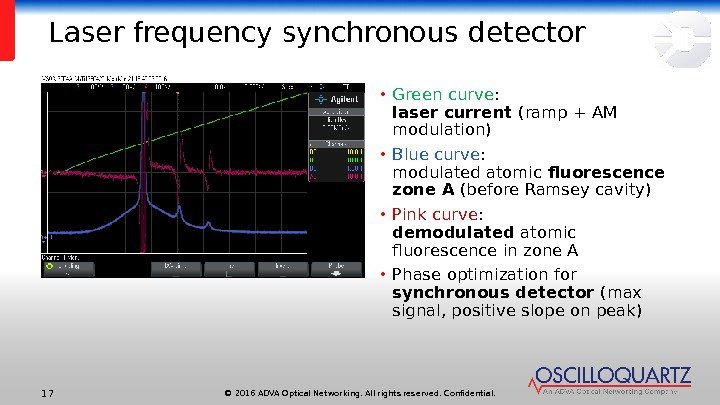
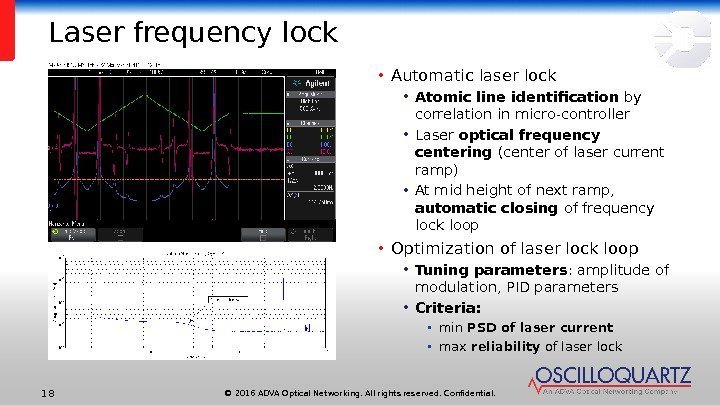
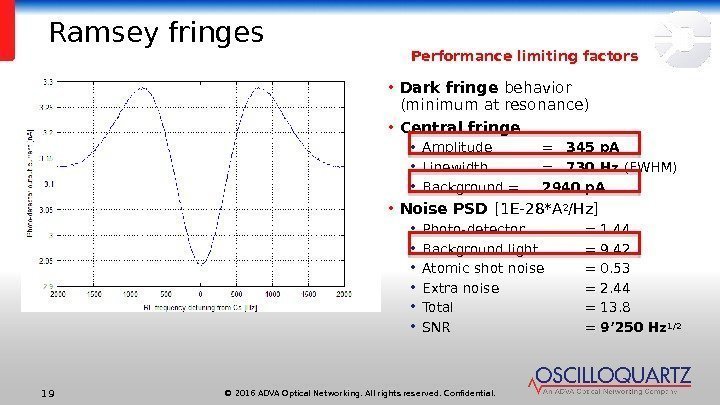
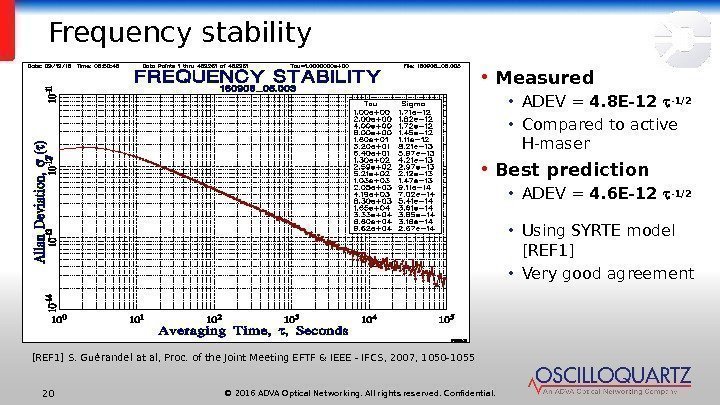
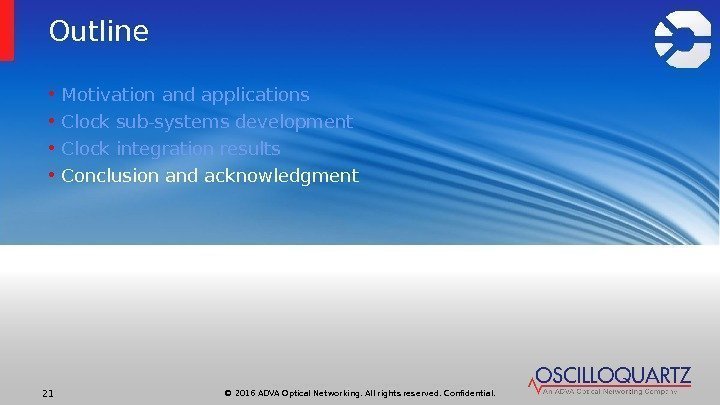
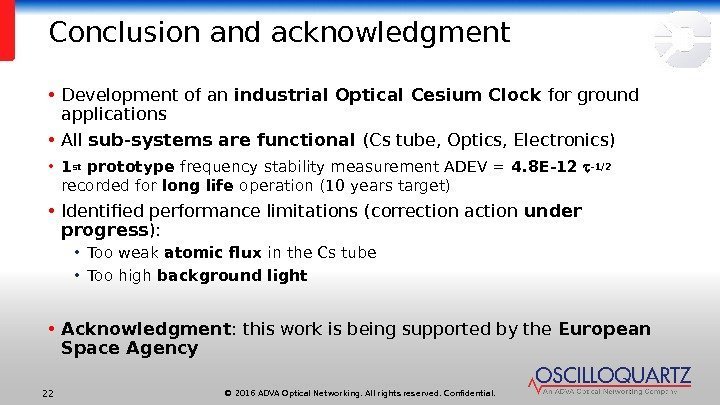
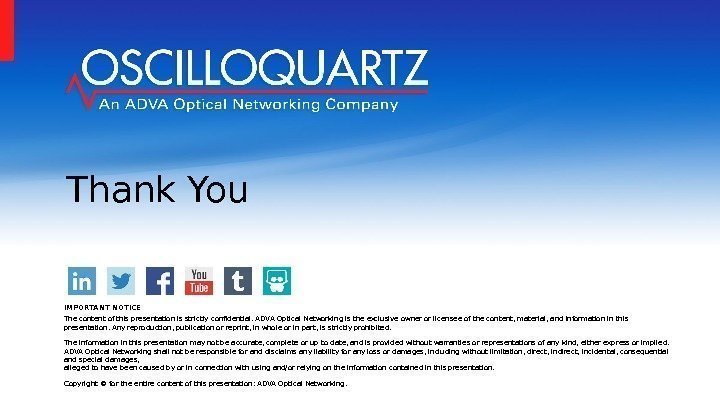
05_optical_cesium_clock_-_pberthoud_-_oscilloquartz_-_ismts_2016.pptx
- Размер: 3.9 Мб
- Автор:
- Количество слайдов: 23
Описание презентации Development of a high performance optical cesium beam по слайдам
 Development of a high performance optical cesium beam clock for ground applications Berthoud Patrick , Chief Scientist Time & Frequency VIII International Symposium, “Metrology of Time and Space”, St. Petersburg, Russia, September 14 -16,
Development of a high performance optical cesium beam clock for ground applications Berthoud Patrick , Chief Scientist Time & Frequency VIII International Symposium, “Metrology of Time and Space”, St. Petersburg, Russia, September 14 -16,
 © 2016 ADVA Optical Networking. All rights reserved. Confidential. 2 Outline • Motivation and applications • Clock sub-systems development • Clock integration results • Conclusion and acknowledgment
© 2016 ADVA Optical Networking. All rights reserved. Confidential. 2 Outline • Motivation and applications • Clock sub-systems development • Clock integration results • Conclusion and acknowledgment
 © 2016 ADVA Optical Networking. All rights reserved. Confidential. 3 Identified markets • Telecommunication network reference • Telecom operators, railways, utilities, … • Science • Astronomy, nuclear and quantum physics, … • Metrology • Time scale, fund. units measurement • Professional mobile radio • Emergency, fire, police • Defense • Secured telecom, inertial navigation • Space (on-board and ground segments) • Satellite mission tracking, GNSS systems
© 2016 ADVA Optical Networking. All rights reserved. Confidential. 3 Identified markets • Telecommunication network reference • Telecom operators, railways, utilities, … • Science • Astronomy, nuclear and quantum physics, … • Metrology • Time scale, fund. units measurement • Professional mobile radio • Emergency, fire, police • Defense • Secured telecom, inertial navigation • Space (on-board and ground segments) • Satellite mission tracking, GNSS systems
 © 2016 ADVA Optical Networking. All rights reserved. Confidential. 4 Available Cs clock commercial products • Long life magnetic Cs clock • Stability : 2. 7 E -11 -1/2 , floor = 5 E -14 • Lifetime : 10 years • Availability : commercial product • High performance magnetic Cs clock • Stability : 8. 5 E -12 -1/2 , floor = 5 E -15 • Lifetime : 5 years • Availability : commercial product • High performance and long life optical Cs clock • Stability : 3. 0 E -12 -1/2 , floor = 5 E -15 • Lifetime : 10 years • Availability : under development
© 2016 ADVA Optical Networking. All rights reserved. Confidential. 4 Available Cs clock commercial products • Long life magnetic Cs clock • Stability : 2. 7 E -11 -1/2 , floor = 5 E -14 • Lifetime : 10 years • Availability : commercial product • High performance magnetic Cs clock • Stability : 8. 5 E -12 -1/2 , floor = 5 E -15 • Lifetime : 5 years • Availability : commercial product • High performance and long life optical Cs clock • Stability : 3. 0 E -12 -1/2 , floor = 5 E -15 • Lifetime : 10 years • Availability : under development
 © 2016 ADVA Optical Networking. All rights reserved. Confidential. 5 Motivation for an Optical Cs clock • Improved performance (short and long-term stability) for: • Metrology and time scales • Science (long-term stability of fundamental constants) • Inertial navigation (sub-marine, GNSS) • Telecom (e. PRTC = enhanced Primary Reference Time Clock) • No compromise between lifetime and performance • Low temperature operation of the Cs oven • Standard vacuum pumping capacity • Large increase of the Cs beam flux by laser optical pumping
© 2016 ADVA Optical Networking. All rights reserved. Confidential. 5 Motivation for an Optical Cs clock • Improved performance (short and long-term stability) for: • Metrology and time scales • Science (long-term stability of fundamental constants) • Inertial navigation (sub-marine, GNSS) • Telecom (e. PRTC = enhanced Primary Reference Time Clock) • No compromise between lifetime and performance • Low temperature operation of the Cs oven • Standard vacuum pumping capacity • Large increase of the Cs beam flux by laser optical pumping
 © 2016 ADVA Optical Networking. All rights reserved. Confidential. 6 Outline • Motivation and applications • Clock sub-systems development • Clock integration results • Conclusion and acknowledgment
© 2016 ADVA Optical Networking. All rights reserved. Confidential. 6 Outline • Motivation and applications • Clock sub-systems development • Clock integration results • Conclusion and acknowledgment
 © 2016 ADVA Optical Networking. All rights reserved. Confidential. 7 Optical Cesium clock architecture • Cs beam generated in the Cs oven (vacuum operation) • Cs atoms state selection by laser • Cs clock frequency probing (9. 192 GHz) in the Ramsey cavity • Atoms detection and amplification by photodetector (air) • Laser and RF sources servo loops using atomic signals
© 2016 ADVA Optical Networking. All rights reserved. Confidential. 7 Optical Cesium clock architecture • Cs beam generated in the Cs oven (vacuum operation) • Cs atoms state selection by laser • Cs clock frequency probing (9. 192 GHz) in the Ramsey cavity • Atoms detection and amplification by photodetector (air) • Laser and RF sources servo loops using atomic signals
 © 2016 ADVA Optical Networking. All rights reserved. Confidential. 8 Optical Pumping vs Magnetic Selection • Atomic energy states • Ground states (F=3, 4) equally populated • Excited states (F’=2, 3, 4, 5) empty • Switching between ground states F by RF interaction 9. 192 GHz without atomic selection (no useful differential signal) • Atomic preparation by magnetic deflection (loss of atoms) • Atomic preparation by optical pumping with laser tuned to F=4 F’=4 transition (gain of atoms)F’=5 F’=4 F’=3 F’=26 P 3/2 RF = 9. 192 GHz. F=4 F=36 S 1/2133 Cs atomic energy levels = 852. 1 nm or opt = 352 THz. Absorption Spontanous emission
© 2016 ADVA Optical Networking. All rights reserved. Confidential. 8 Optical Pumping vs Magnetic Selection • Atomic energy states • Ground states (F=3, 4) equally populated • Excited states (F’=2, 3, 4, 5) empty • Switching between ground states F by RF interaction 9. 192 GHz without atomic selection (no useful differential signal) • Atomic preparation by magnetic deflection (loss of atoms) • Atomic preparation by optical pumping with laser tuned to F=4 F’=4 transition (gain of atoms)F’=5 F’=4 F’=3 F’=26 P 3/2 RF = 9. 192 GHz. F=4 F=36 S 1/2133 Cs atomic energy levels = 852. 1 nm or opt = 352 THz. Absorption Spontanous emission
 © 2016 ADVA Optical Networking. All rights reserved. Confidential. 9 RFLaser. RFCesium clock: Magnetic vs. Optical • Weak flux • Strong velocity selection (bent) • Magnetic deflection ( atoms kicked of ) • Typical performances: • 2. 7 E -11 -1/2 • 10 years • Stringent alignment (bent beam) • Critical component under vacuum (electron multiplier) • High flux (x 100) • No velocity selection (straight) • Optical pumping ( atoms reused ) • Typical performances: • 2. 7 E -12 -1/2 • 10 years • Relaxed alignment (straight beam) • Critical component outside vacuum (laser)
© 2016 ADVA Optical Networking. All rights reserved. Confidential. 9 RFLaser. RFCesium clock: Magnetic vs. Optical • Weak flux • Strong velocity selection (bent) • Magnetic deflection ( atoms kicked of ) • Typical performances: • 2. 7 E -11 -1/2 • 10 years • Stringent alignment (bent beam) • Critical component under vacuum (electron multiplier) • High flux (x 100) • No velocity selection (straight) • Optical pumping ( atoms reused ) • Typical performances: • 2. 7 E -12 -1/2 • 10 years • Relaxed alignment (straight beam) • Critical component outside vacuum (laser)
 © 2016 ADVA Optical Networking. All rights reserved. Confidential. 10 Clock functional bloc diagram • Cs tube • Generate Cs atomic beam in ultra high vacuum enclosure • Optics • Generate 2 optical beams from 1 single frequency laser (no acousto-optic modulator) • Electronics • Cs core electronics for driving the Optics and the Cs tube • External modules for power supplies, management, signals I/O
© 2016 ADVA Optical Networking. All rights reserved. Confidential. 10 Clock functional bloc diagram • Cs tube • Generate Cs atomic beam in ultra high vacuum enclosure • Optics • Generate 2 optical beams from 1 single frequency laser (no acousto-optic modulator) • Electronics • Cs core electronics for driving the Optics and the Cs tube • External modules for power supplies, management, signals I/O
 © 2016 ADVA Optical Networking. All rights reserved. Confidential. 11 Clock architecture (top view) • Cesium core is not customizable • External modules are customizable: • Power supplies • Signal outputs • Management
© 2016 ADVA Optical Networking. All rights reserved. Confidential. 11 Clock architecture (top view) • Cesium core is not customizable • External modules are customizable: • Power supplies • Signal outputs • Management
 © 2016 ADVA Optical Networking. All rights reserved. Confidential. 12 Cs tube sub-assembly Laser viewports Photo-detectors viewports Ion pump. Pinch-off tube Vacuum enclosure Tube fixation
© 2016 ADVA Optical Networking. All rights reserved. Confidential. 12 Cs tube sub-assembly Laser viewports Photo-detectors viewports Ion pump. Pinch-off tube Vacuum enclosure Tube fixation
 © 2016 ADVA Optical Networking. All rights reserved. Confidential. 13 Optics sub-assembly • Optical sub-system • Free space propagation • Single optical frequency (no acousto-optic modulator) • Redundant laser modules (2) • No optical isolator • Ambient light protection by cover and sealing (not shown here) • Laser module • DFB 852 nm , TO 3 package • Narrow linewidth (<1 MHz)
© 2016 ADVA Optical Networking. All rights reserved. Confidential. 13 Optics sub-assembly • Optical sub-system • Free space propagation • Single optical frequency (no acousto-optic modulator) • Redundant laser modules (2) • No optical isolator • Ambient light protection by cover and sealing (not shown here) • Laser module • DFB 852 nm , TO 3 package • Narrow linewidth (<1 MHz)
 © 2016 ADVA Optical Networking. All rights reserved. Confidential. 14 Physics Package Optics Cs tube Laser modules (redundant) Photo-detectors modules
© 2016 ADVA Optical Networking. All rights reserved. Confidential. 14 Physics Package Optics Cs tube Laser modules (redundant) Photo-detectors modules
 © 2016 ADVA Optical Networking. All rights reserved. Confidential. 15 Complete Cs clock • Front and top view • LCD touchscreen • Optics + Cs tube in front • Core electronics • Rear view • Power supplies (AC, DC, Battery) • Sinus Outputs (5, 100 MHz) • Sync 1 PPS (1 x In, 4 x Out) • Management (RS 232, Ethernet, Alarms) • Dimensions: standard 19” rack (450 x 133 x 460 mm 3) • Mass: 17. 5 kg • Power consumption: 35 W
© 2016 ADVA Optical Networking. All rights reserved. Confidential. 15 Complete Cs clock • Front and top view • LCD touchscreen • Optics + Cs tube in front • Core electronics • Rear view • Power supplies (AC, DC, Battery) • Sinus Outputs (5, 100 MHz) • Sync 1 PPS (1 x In, 4 x Out) • Management (RS 232, Ethernet, Alarms) • Dimensions: standard 19” rack (450 x 133 x 460 mm 3) • Mass: 17. 5 kg • Power consumption: 35 W
 © 2016 ADVA Optical Networking. All rights reserved. Confidential. 16 Outline • Motivation and applications • Clock sub-systems development • Clock integration results • Conclusion and acknowledgment
© 2016 ADVA Optical Networking. All rights reserved. Confidential. 16 Outline • Motivation and applications • Clock sub-systems development • Clock integration results • Conclusion and acknowledgment
 © 2016 ADVA Optical Networking. All rights reserved. Confidential. 17 Laser frequency synchronous detector • Green curve : laser current (ramp + AM modulation) • Blue curve : modulated atomic fluorescence zone A (before Ramsey cavity) • Pink curve : demodulated atomic fluorescence in zone A • Phase optimization for synchronous detector (max signal, positive slope on peak)
© 2016 ADVA Optical Networking. All rights reserved. Confidential. 17 Laser frequency synchronous detector • Green curve : laser current (ramp + AM modulation) • Blue curve : modulated atomic fluorescence zone A (before Ramsey cavity) • Pink curve : demodulated atomic fluorescence in zone A • Phase optimization for synchronous detector (max signal, positive slope on peak)
 © 2016 ADVA Optical Networking. All rights reserved. Confidential. 18 Laser frequency lock • Automatic laser lock • Atomic line identification by correlation in micro-controller • Laser optical frequency centering (center of laser current ramp) • At mid height of next ramp, automatic closing of frequency lock loop • Optimization of laser lock loop • Tuning parameters : amplitude of modulation, PID parameters • Criteria: • min PSD of laser current • max reliability of laser lock
© 2016 ADVA Optical Networking. All rights reserved. Confidential. 18 Laser frequency lock • Automatic laser lock • Atomic line identification by correlation in micro-controller • Laser optical frequency centering (center of laser current ramp) • At mid height of next ramp, automatic closing of frequency lock loop • Optimization of laser lock loop • Tuning parameters : amplitude of modulation, PID parameters • Criteria: • min PSD of laser current • max reliability of laser lock
 © 2016 ADVA Optical Networking. All rights reserved. Confidential. 19 Ramsey fringes • Dark fringe behavior (minimum at resonance) • Central fringe • Amplitude = 345 p. A • Linewidth = 730 Hz (FWHM) • Background = 2940 p. A • Noise PSD [1 E-28*A 2 /Hz] • Photo-detector = 1. 44 • Background light = 9. 42 • Atomic shot noise = 0. 53 • Extra noise = 2. 44 • Total = 13. 8 • SNR = 9’ 250 Hz 1/2 Performance limiting factors
© 2016 ADVA Optical Networking. All rights reserved. Confidential. 19 Ramsey fringes • Dark fringe behavior (minimum at resonance) • Central fringe • Amplitude = 345 p. A • Linewidth = 730 Hz (FWHM) • Background = 2940 p. A • Noise PSD [1 E-28*A 2 /Hz] • Photo-detector = 1. 44 • Background light = 9. 42 • Atomic shot noise = 0. 53 • Extra noise = 2. 44 • Total = 13. 8 • SNR = 9’ 250 Hz 1/2 Performance limiting factors
 © 2016 ADVA Optical Networking. All rights reserved. Confidential. 20 Frequency stability • Measured • ADEV = 4. 8 E-12 -1/2 • Compared to active H-maser • Best prediction • ADEV = 4. 6 E-12 -1/2 • Using SYRTE model [REF 1] • Very good agreement [REF 1] S. Guérandel at al, Proc. of the Joint Meeting EFTF & IEEE — IFCS, 2007, 1050 —
© 2016 ADVA Optical Networking. All rights reserved. Confidential. 20 Frequency stability • Measured • ADEV = 4. 8 E-12 -1/2 • Compared to active H-maser • Best prediction • ADEV = 4. 6 E-12 -1/2 • Using SYRTE model [REF 1] • Very good agreement [REF 1] S. Guérandel at al, Proc. of the Joint Meeting EFTF & IEEE — IFCS, 2007, 1050 —
 © 2016 ADVA Optical Networking. All rights reserved. Confidential. 21 Outline • Motivation and applications • Clock sub-systems development • Clock integration results • Conclusion and acknowledgment
© 2016 ADVA Optical Networking. All rights reserved. Confidential. 21 Outline • Motivation and applications • Clock sub-systems development • Clock integration results • Conclusion and acknowledgment
 © 2016 ADVA Optical Networking. All rights reserved. Confidential. 22 Conclusion and acknowledgment • Development of an industrial Optical Cesium Clock for ground applications • All sub-systems are functional (Cs tube, Optics, Electronics) • 1 st prototype frequency stability measurement ADEV = 4. 8 E-12 -1/2 recorded for long life operation (10 years target) • Identified performance limitations (correction action under progress ): • Too weak atomic flux in the Cs tube • Too high background light • Acknowledgment : this work is being supported by the European Space Agency
© 2016 ADVA Optical Networking. All rights reserved. Confidential. 22 Conclusion and acknowledgment • Development of an industrial Optical Cesium Clock for ground applications • All sub-systems are functional (Cs tube, Optics, Electronics) • 1 st prototype frequency stability measurement ADEV = 4. 8 E-12 -1/2 recorded for long life operation (10 years target) • Identified performance limitations (correction action under progress ): • Too weak atomic flux in the Cs tube • Too high background light • Acknowledgment : this work is being supported by the European Space Agency
 Thank You IMPORTANT NOTICE The content of this presentation is strictly confidential. ADVA Optical Networking is the exclusive owner or licensee of the content, material, and information in this presentation. Any reproduction, publication or reprint, in whole or in part, is strictly prohibited. The information in this presentation may not be accurate, complete or up to date, and is provided without warranties or representations of any kind, either express or implied. ADVA Optical Networking shall not be responsible for and disclaims any liability for any loss or damages, including without limitation, direct, incidental, consequential and special damages, alleged to have been caused by or in connection with using and/or relying on the information contained in this presentation. Copyright © for the entire content of this presentation: ADVA Optical Networking.
Thank You IMPORTANT NOTICE The content of this presentation is strictly confidential. ADVA Optical Networking is the exclusive owner or licensee of the content, material, and information in this presentation. Any reproduction, publication or reprint, in whole or in part, is strictly prohibited. The information in this presentation may not be accurate, complete or up to date, and is provided without warranties or representations of any kind, either express or implied. ADVA Optical Networking shall not be responsible for and disclaims any liability for any loss or damages, including without limitation, direct, incidental, consequential and special damages, alleged to have been caused by or in connection with using and/or relying on the information contained in this presentation. Copyright © for the entire content of this presentation: ADVA Optical Networking.

